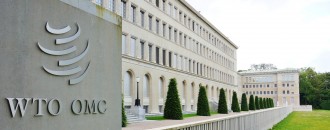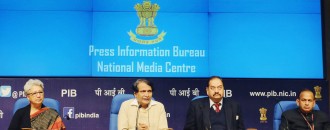
A very special Labour Day!
Steven Philip Warner | The Dollar Business
 There is no denying that the new Foreign Trade Policy comes with many incremental alterations. But humans err. Which is why FTP 2015-2020 isn’t flawless!
There is no denying that the new Foreign Trade Policy comes with many incremental alterations. But humans err. Which is why FTP 2015-2020 isn’t flawless!May 1st is a special date. Today, The Dollar Business (TDB) launched its 12th issue – it’s a year old giant now! We consider it a milestone – not one that has every concerned TDB insider bouncing off the walls, but definitely one that titillates our nerves to the extent that the resonance can be heard through a stethoscope. What makes this Labour Day special is that it marks a year since TDB got its first online impression (as I write, the online visitor counting ticker on our website reads 2,06,946!), ensuring that we’re able to grin from ear to ear when our readers read our differentiated online articles on foreign trade and access the bug-free e-version of the 12th issue of magazine. From print to digital, The Dollar Business has grown in mighty leaps. On this landmark date, I thought, why not pen down my thoughts on the most important development in foreign trade in the past 12 months, and one that will remain just that for some time to come. The New Foreign Trade Policy (FTP) 2015-2020. What makes the new FTP special besides the fact that it did get the foreign trade fraternity more than just anxious, is that it is a representation of the avowed intent of the new government to take India’s foreign trade to newer highs. Ambitious. What other remark can explain an exports target of $900 billion by FY2020? Going by India’s current total (merchandise and services) exports of $472.82 billion (in CY2014 as per ITC, UNCTAD, WTO joint dataset), for matters to come up roses, a CAGR of 13.74% in overall exports would be required – almost equal to China’s record (13.78%) and much higher than India’s in the past five years (11.89%)! And that will call for pulling out all the stops. Possibly the reason why the new FTP, though appearing incremental in nature on the surface, has the right intent on display from the policymaking wing. There are unmissable positives in the FTP. Combination and simplification of erstwhile Chapter 3 schemes that offered unique duty credit scrips with varying conditions that existed in the earlier policy (into a new scheme called Merchandise Exports from India Scheme – MEIS) is a significant move to introduce uniformity in India’s foreign trade procedures. What’s impressive about MEIS is that while in the earlier version of the policy, traditional ‘big and First World’ markets like USA, Canada and EU were more often than not excluded from sops offered under Chapter 3 incentive schemes, these have been generously treated in the new FTP. Actually, in many cases more generously than even underdeveloped and island countries. One takeaway from this pro-capitalistic move is that the current government means more logic and more business. The Service Exports from India Scheme – SEIS – is by far the single-most popular and promising announcement this policy. Change of classification of eligible service exporters from “Indian Service Providers” to “Service Providers located in India” and the alteration in nature of scrips to “freely transferable” are definitely indications that the DGFT is done with all the toing and froing. If it’s about incentives, it wants them to get real! Giving manufacturers who are status-holders (3-star and above) the power to self-certify the origin of their manufactured goods, making SEZs eligible for duty credit scrips (which will incentivise growth of export-manufacturing units in SEZs), lowering Export Obligation by 25% in the case of domestic procurement of inputs under the Export Promotion Capital Goods (EPCG) scheme (that will provide the desired impetus to Make in India), ensuring that facilities for both 24x7 and single window customs clearance systems are implemented, trying to ensure a seamless flow of information and centrally shared database for real-time tracking (this has been a concern for long, as expressed in the September 2014 Report of the Tax Administration Reform Committee – TARC – report), joining hands with willing academic and research knowledge partners, declaring an intent to issue the e-IEC (Electronic Importer Exporter Code) within two working days (where earlier it would take weeks!) are some new features of the new FTP, and obvious improvements over the former version. But humans err. Which is why the new FTP isn’t flawless. Problem with the modern society is that its concerned agents fail to read. If they read, they fail to listen. And if they listen, they fail to act! A similar problem with India’s foreign trade can be seen in the new FTP, and experienced on the ground. And so some questions come to mind. Allow us to throw the first ten that come to mind. (a) To begin with MEIS, various products under HS Code chapter headings 06, 08, 12, 13, 14, 15, 20, 23, 30, etc., that were offered a 5% credit scrip under VKGUY have now been excluded under MEIS. What’s the one rationale that explains the heedless across the board chopping? (b) Allowing duty credit scrips for SEZs – good move, yes. But why are SEZ manufactured products exported from DTA units made ineligible from incentives under MEIS? (c) Under para 3.06 of FTP that outlines ineligible categories under MEIS, Sugar of all types and all forms, export of milk and milk products and export of meat and meat products have been added to the list. However in Appendix 3B, there are products mentioned that violate the very provision of para 3.06. What’s the justification? (d) In the previous FTP, there existed a methodology of classification of certain exports as artistic work(s). As per a DGFT Circular, for grant of benefit under VKGUY Scheme (for export of identified ‘Artistic Wooden Furniture’), exporters were required to get the invoices duly certified by EPCH, All India or State Handicraft Boards, etc. Given that this provision is missing in the new policy, will any exporter claim any wooden product to be a work of art? (e) The other side to the SEIS coin is that it appears to be too generous a scheme. General opinion is that the unplanned, excessively abundant supply of credit scrips that result from SEIS will lead to both incentivisation of imports, and loss of customs revenues. And the fact that SEIS as a scheme is only a pilot test is confirmed by the first note on the DGFT Circular that states “The services and rates of rewards notified against them [SEIS] shall be applicable for services export made between 1-4-2015 to 30-09-2015 only. The list of services/rate is subject to review with effect from 1-10-2015.” What is surprising is that para 3.04 sub-para (b) of the Handbook of Procedures clearly states thus: “An application for grant of duty credit scrip for eligible services rendered shall be filed online for a financial year on annual basis…” So will DGFT now demand a half-yearly statement to determine the Net Foreign Exchange earned by various service importers to decide on the incentives due to each of them, and the overall impact on the coffers of the Department of Revenue? And why have sectors like telecom and project exports been altogether omitted from the list of eligible sectors under the scheme? (f) Status holders have been empowered by the new policy to self-certify the origin of their manufactured goods. But can the exporters be assured that our trading partners – under PTAs, FTA, RTAs, etc. – will agree to this? (g) Sub-para (ii) of para 4.09 of FTP states thus: “Export Products where value addition could be less than 15% are given in Appendix 4D”. We noted that there are just two widely classified products in this particular appendix: (a) Copper; and (b) Petroleum product(s). In both cases, the MVA required is just 8%. Why not reduce the MVA levels under Advance Authorisation from the current 15%? And if not, why not expand the basket to other products? (h) The new DFIA scheme looks similar to the erstwhile DFRC (Duty Free Replenishment Certificate) scheme. However, certain exemptions that existed in DFRC have been withdrawn from DFIA despite other provisions being kept unchanged. For one, we fail to understand the logic behind stripping away Terminal Excise Duty (TED) refund from DFIA, considering that supply against both DFRC and DFIA was/is eligible for deemed exports! (i) As per our investigation, across various sea and airports, the 24x7 Customs clearance system that the FTP outlines in para 1.25 has apparently “not been implemented fully”. Interestingly, the FTP only talks of the facility and not about the deadline for implementation. How about onlookers who opine that “customs will not support this move of government for facilitating trade”? (j) What should we make of Customs’ interpretation of SFIS – Customs notification no.25/2015, dated 8th April 2015, that talks about “imports and exports of services through ports”? Despite the handful of questions I have raised here and the many others voiced by experts across the manufacturing and service industries, there is no denying that the new FTP comes as a relief to the foreign trade community and that it is a stable, incremental draft that comes packed with sincere intent on the part of guardians in the ranks across DGFT and the government ranks to Make in India and Make India in foreign trade, by keeping their noses to the grindstone. As for us, with India having hitched its export wagon to a $900 billion star, we will continue to have our hearts set on being the foremost in the field of foreign trade! How a matter of twelve months can mean so differently to two stakeholder groups! For the foreign trade community, the past year has been a long wait; for TDB, the targets we set to cross in the very first year, days meant seconds. But they who respect the mission of India’s foreign trade community and appreciate the toil and vision of The Dollar Business, they know… the 12 months meant the same for both groups. We waited besides them, while they cheered us on. And suddenly we’ve started thinking: Is trade possible beyond this very planet?
May 1, 2015 | 4:31 pm IST.





 to success.
to success.